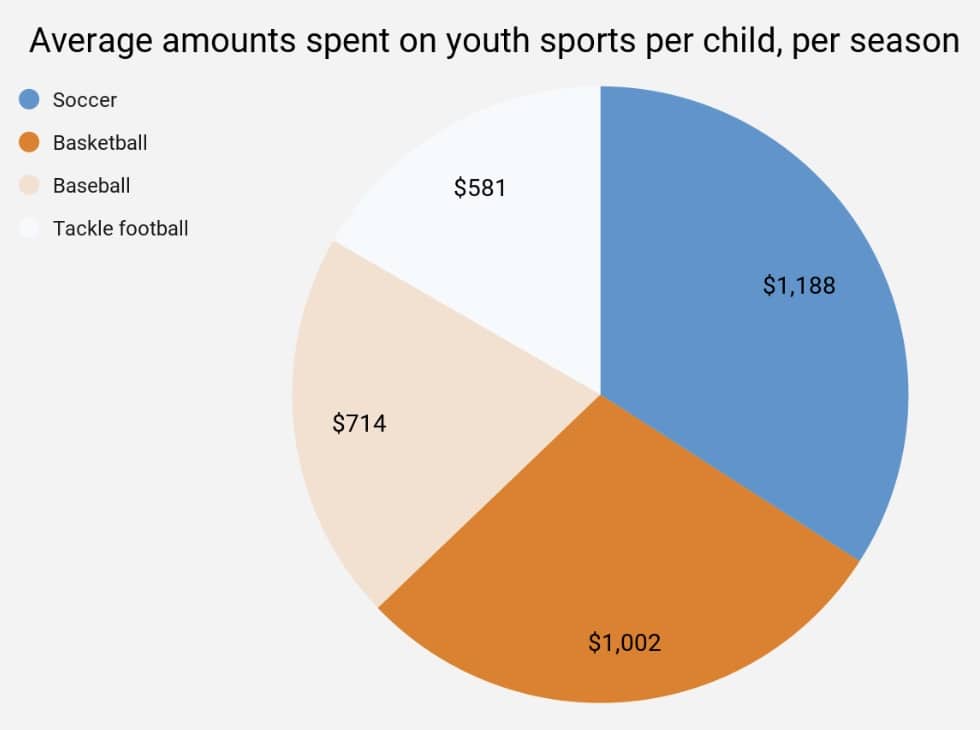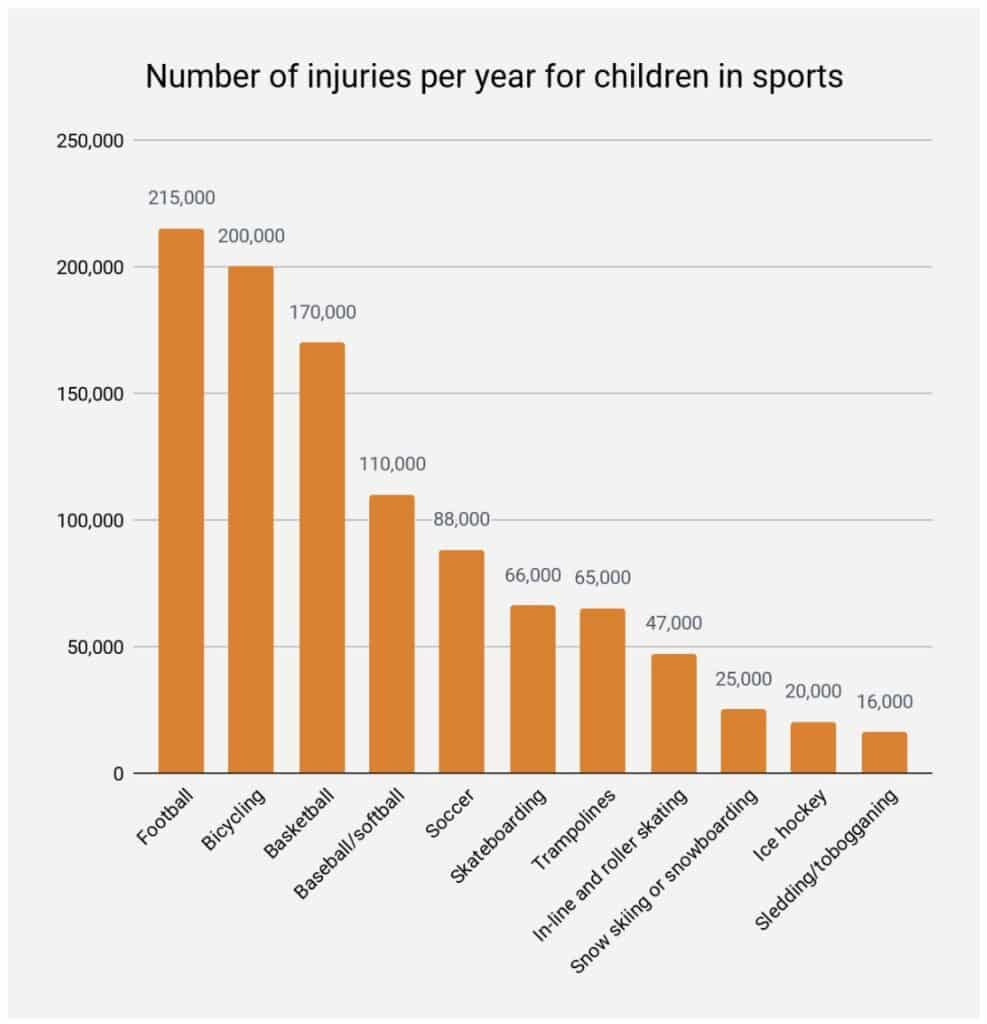
Who can be held liable when your child is injured in the field or on the court?
Learn about the common causes of action and the common legal defenses following a Florida youth sports accident.
Youth sports have never been more popular than they are today.
Whether you think your child is the next Aaron Judge or Simone Biles, or they just love their sport of choice and play for fun, it’s the unfortunate reality that sports injuries happen, even to kids.
About 30 million children in the U.S. participate in organized youth sports. In a recent year, more than 170,000 boys and nearly 135,000 girls participated in high school athletics in Florida, alone.
In 2020, more than 54% of children ages 6-17 participated in sports. And, it’s no wonder—the CDC reports that kids who participate on a sports team have improved physical and mental health, and higher quality physical activity.
Youth sports come at a cost—literally. A survey by Project Play with the Utah State University’s Families in Sports Lab found that the average youth sports family spent $883 on one child’s primary sport per season.
For some sports, that figure is even higher.
The average costs to parents for a season of youth sports include:

The costliest feature of youth sports is travel. Other costs include equipment, private training, registration fees and camps.
However, the financial number isn’t the only cost to youth sports. Hospitals report more than 3.5 million youth sports injuries each year. Nearly ⅓ of all childhood injuries are sports-related, according to a report by Stanford Medicine Children’s Health.
Types of youth sports injuries
There are two primary ways children become injured during sports: Trauma from a specific accident, or overuse or misuse of a body part.
The National SAFE KIDS Campaign and the American Academy of Pediatrics offer these youth sports statistics:
- More than 3.5 million children ages 14 and under are injured yearly in sports.
- The leading cause of sports-related death among children is brain injuries.
- 21% of all traumatic brain injuries to American children are caused by sports and recreational activities.
- About 50% of head injuries from sports or recreation involve bicycling, skateboarding or skating accidents.
- Most of the 775,000 sports injuries in children treated in hospitals each year are from falls, being struck by an object, collisions, or overexertion in unorganized or informal sports games.
- The highest rates of injury are in contact sports and from collisions.
- 62% of sports injuries happen during practice.
Number of youth sports injuries by activity
Who’s liable for a Florida youth sports-related injury?
Aside from the cost of the sport, itself, what if your child is injured and you wind up with extensive medical bills? Or if you have to quit your job or take a leave of absence to care for an injured child? Or if your child suffers a traumatic injury that changes the trajectory of their life, and they now have a disability or special needs that will cost a lot of money for services?
No parent wants to consider these possibilities as you’re cheering from the sidelines, but it’s worth thinking about if your child is involved in athletics.
Sometimes, accidents happen and they are unavoidable. But what if your child’s injury didn’t have to happen? What if it was preventable and it happened because of someone’s negligence?
That’s when you begin to think about whether a lawsuit can help you regain the costs for the injury and determine who is at fault. At its core, personal injury law is intended to make a plaintiff (the injured person) whole. While no lawsuit can restore your child’s physical well-being, it’s intended to restore you to the financial condition you would be in if the accident hadn’t happened.
If you’re considering a lawsuit, the first question is whether someone (a person or entity) was negligent.
A person is negligent if they were careless in a way that meets these elements:
- Duty. Everyone has a duty to someone else at some time, which can change from moment to moment. In this instance, a duty is owed by coaches, fellow players, the organization responsible for maintaining safe play areas, and anyone else who can have a direct effect on your child’s playing.
- Breach. If duty is breached, it means the negligent person did not take reasonable care to avoid harm or injury to the plaintiff.
- Causation. The plaintiff must prove that the defendant’s action or lack of action was the reason why their injury occurred.
- Injury. In order to file a lawsuit, there needs to be an actual injury. If another player trips your child during a game and the refs don’t notice, it could cause your child’s team to lose but if your child isn’t physically injured, there is no basis for a lawsuit.
- Damages. It’s devastating that your child got hurt, but the court system doesn’t award damages for sadness or anger. The legal system is designed to make an injured plaintiff financially “whole.” This means they are entitled to be restored to the financial condition they would be in if the accident hadn’t happened.
“Damages” are the money a plaintiff can recover through a settlement or judgment. The injury has to have cost you money in order to file a claim.
Potential defendants
There are numerous possibilities for individuals or organizations who could be liable for a child’s Florida sports injury. Liability depends wholly on the facts of the incident.
If your child suffered a traumatic injury (i.e. from a specific accident), you might consider the following liable parties:
- Coaches or sports team/organization. The coach and the organization are responsible for properly training and supervising players. It’s also their responsibility to ensure that each player has appropriate protective equipment and that the safety gear is properly maintained and well-fitting.
- Other players. In some sports, playing rough-and-tumble is part of the game. But if another player is reckless or intentional in causing an injury, they could be liable. Even in sports, there’s a reasonableness standard. There is a level of roughness that’s reasonable and certain injuries that are foreseeable in particular sports, but if the action or behavior exceeds that threshold, it could be considered negligent.
- Property owner or manager. This might be a school or the owner or manager of a stadium or recreational facility. Premises liability is the area of law that provides compensation for an injury caused by a hazard on property. If the fields or turf are too slippery, have holes or unevenness, or are otherwise poorly maintained in a way that causes an injury, the manager or owner of that facility could be held liable.
- Manufacturer of helmet or other safety gear. Although it’s the responsibility of the youth sports organization to check helmets and safety gear regularly, there could be a defect that’s not immediately apparent. If your child is injured because of defective equipment, you might be able to hold the manufacturer responsible.
- Spectators. Spectators are unlikely defendants, as they would not generally have an effect on how the game is played or what happens on the field. Players expect shouting, cheering, even jeers, when they play. But if a spectator interferes with the game in a way that causes an accident (for instance, throwing something onto the field or court), they could be liable for an injury.
- Physician. If a physician misdiagnoses a condition, fails to diagnose a condition, or gives improper advice (for example, allowing a patient to be cleared for play when their condition isn’t conducive to returning to the sport), they can be liable for medical malpractice.
Overuse injuries
Not every young athlete’s injury is because of a hard tackle or a fastball.
Overuse injuries are common in children and teens who play sports. An overuse injury is damage to a bone, muscle, ligament or tendon that’s caused by repetitive stress without enough time for the body to heal.
Symptoms of overuse injuries have four stages:
- Pain in the affected area after physical activity
- Pain during physical activity, not restricting performance
- Pain during physical activity, restricting performance
- Chronic, persistent pain, even at rest.
There are a few ways to avoid overuse injuries, including:
- Avoiding participating in a particular sport more than five days per week
- Taking at least one day off per week from organized activity
- Taking a combined three months off per year from a specific sport, while still remaining physically active in other ways
- Performing proper warm-up and cool-down exercises
- Varying endurance workouts to include multiple activities
Coaches, your child’s pediatrician, and other adults who oversee team sports should be watching for warnings of overuse and monitoring children’s activities to prevent this type of injury.
Assumption of the risk and liability waivers
Whether your child is an athlete or not, you’ve undoubtedly had to sign a waiver from time to time that allows them to participate in an activity and includes a hold harmless provision that would prevent you from filing a lawsuit against the facility or organizer if your child is hurt.
The assumption of the risk doctrine says that a plaintiff who voluntarily participates in a sports activity is owed no duty of care with respect to the obvious risks associated with the activity. This is a common defense in these types of lawsuits.
The Florida Supreme Court has ruled that this is only valid where there’s an express assumption of risk, where the plaintiff has signed a contract not to sue or for an injury caused during a contact sport.
However, a defendant could be liable if they intentionally injured or were reckless in a way that caused an injury, or that was beyond the scope of ordinary risk for that particular activity. One example is if a batter is injured because they were hit by a fast pitch, that’s a reasonable risk of the game. If the pitcher is injured because the batter intentionally threw the bat at them in frustration after striking out, this is intentional and reckless behavior and the pitcher would not be expected to have assumed that risk.
Is a Florida parent liable if their child causes injury to another child?
Florida parental responsibility laws do not provide for a sports-related injury, specifically.
Under Florida law, there are two instances when a parent or legal guardian is responsible for their child’s negligent behavior: When the child is driving and causes an accident, and in the event that the child commits vandalism or theft.
If a Florida child “maliciously or willfully destroys or steals property, real, personal, or mixed,” the parent is financially responsible for the damages. This responsibility is limited to actual damages and court costs, but there is no provision for pain and suffering or other non-economic harm.
However, If the parent is aware that their child is likely to act recklessly or carelessly, they must take reasonable steps to prevent the child from causing foreseeable harm to another person.
If your child was injured while playing or practicing for a sport, you can contact a Florida personal injury lawyer for guidance if you believe you might need to file a lawsuit.
See our guide Choosing a personal injury attorney.




